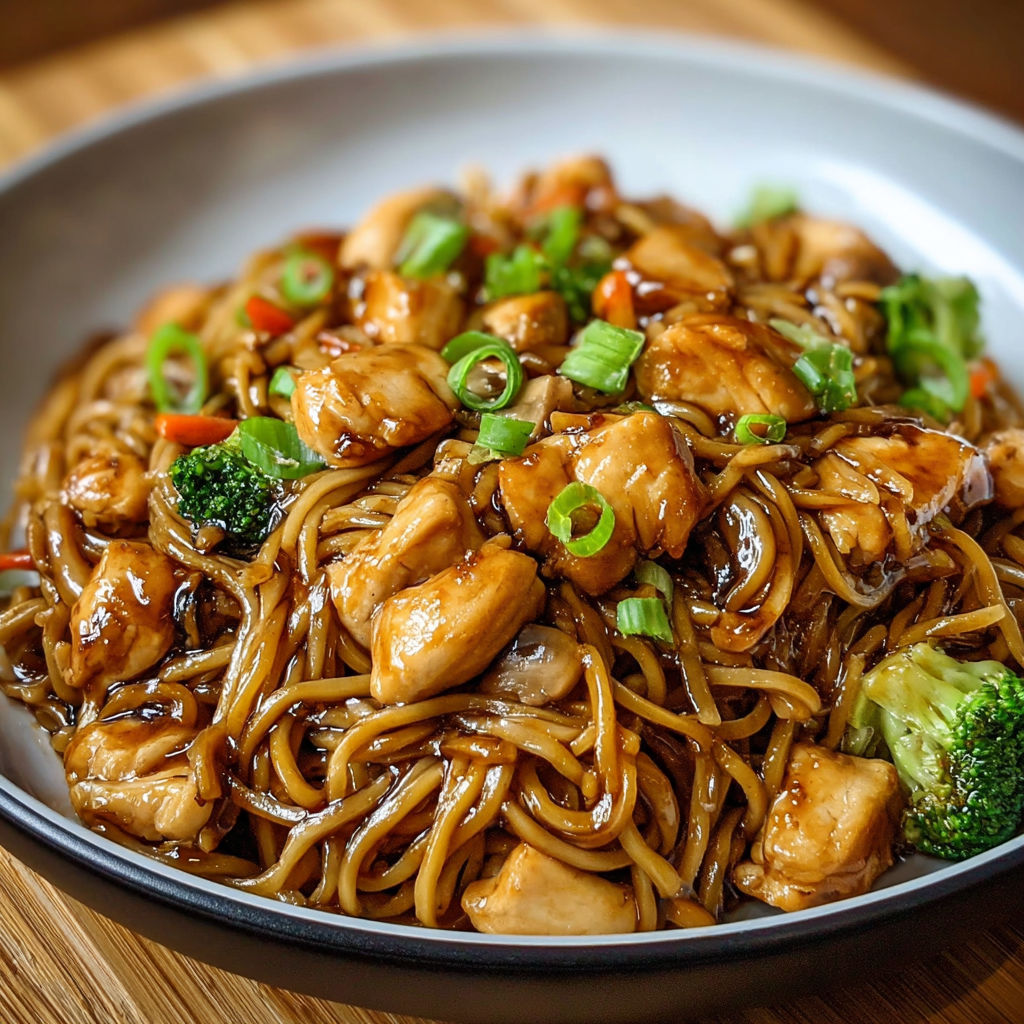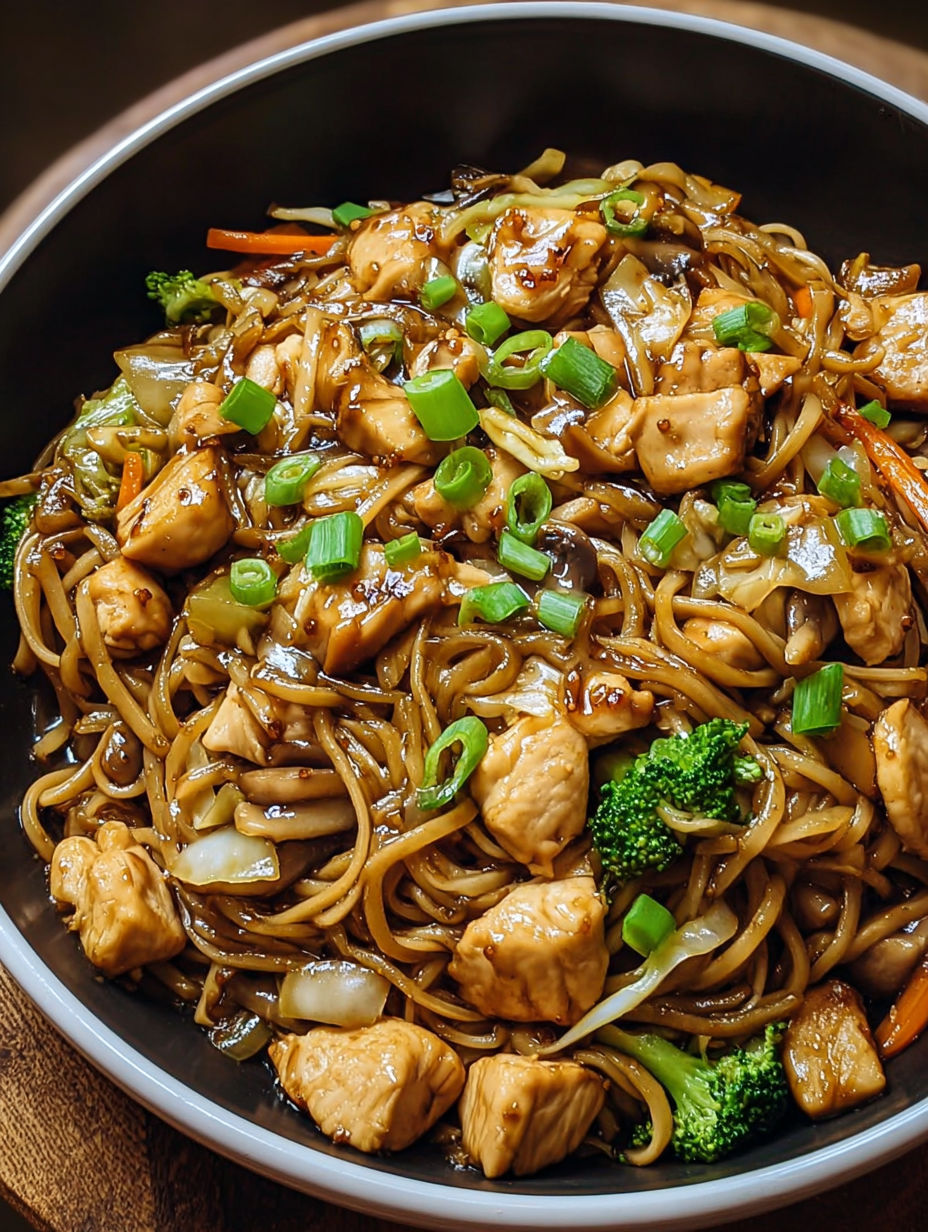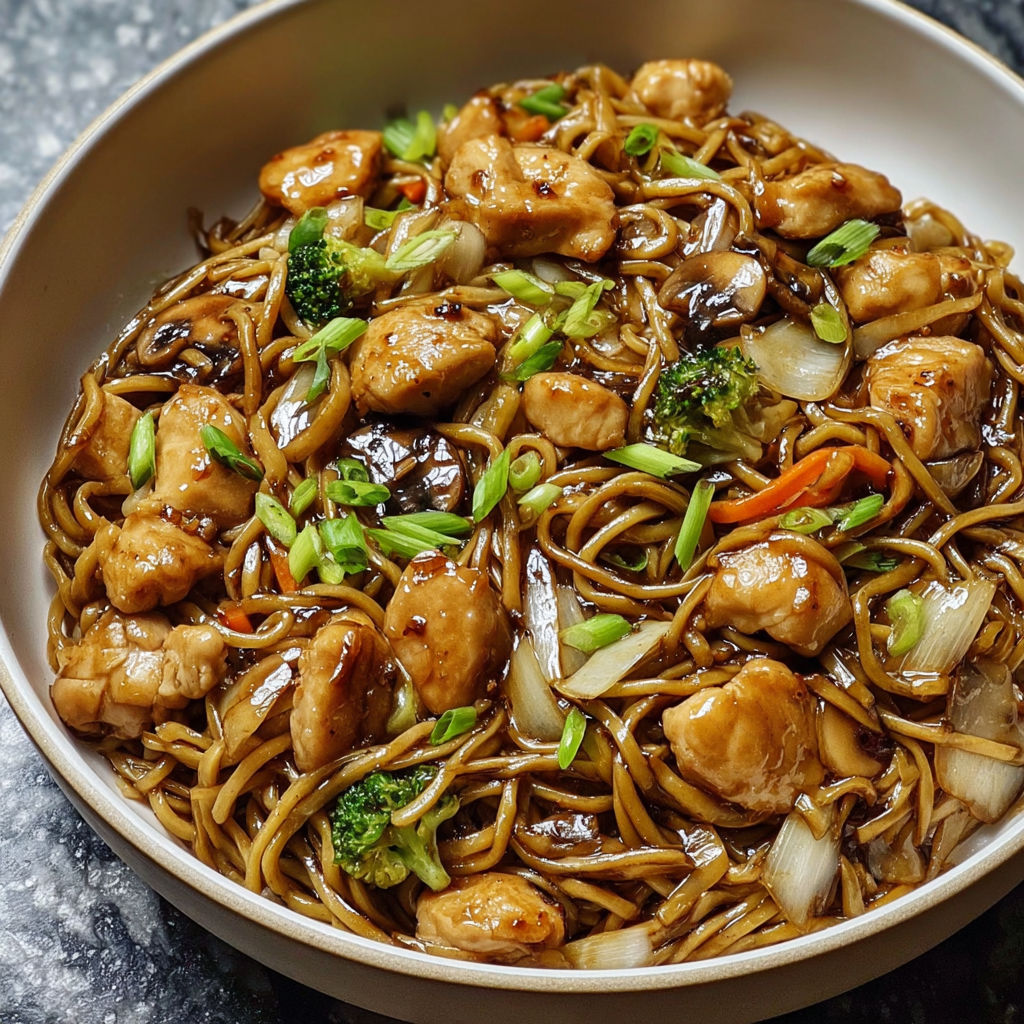 Pin
Pin
This garlic-infused chicken lo mein bursts with Asian flavors and comes together faster than takeout. The combination of tender chicken, crisp vegetables, and slurpable noodles creates a perfectly balanced one-pan meal that satisfies even the strongest Chinese food cravings.
I first created this recipe when trying to recreate my favorite takeout dish without leaving home. What started as a kitchen experiment has become our Thursday night tradition when we need something quick but still want to feel like we're treating ourselves.
Ingredients
- Chicken breasts provides lean protein and takes on flavors beautifully
- Garlic powder infuses the chicken with flavor before cooking begins
- Fish sauce adds that essential umami depth that makes Asian dishes sing
- Fresh ginger brings warming spice and authenticity to both chicken and vegetables
- Minced garlic cloves create the aromatic base this dish is named for
- Cabbage adds sweetness and crunch when just slightly cooked
- Broccoli florets provide texture and absorb the savory sauce perfectly
- Carrots offer natural sweetness and beautiful color contrast
- Green onions deliver mild onion flavor and fresh garnish
- Mushrooms contribute meaty texture and earthy flavor
- Celery adds crunch and subtle flavor that balances the strong aromatics
- Buckwheat lo mein noodles have a nutty flavor and hearty texture
- Soy sauce creates the savory base for our sauce
- Hoisin sauce adds sweetness and complexity to balance the salty elements
- Szechuan garlic butter takes this dish from good to incredible with its rich spicy notes
How To Make Garlic Chicken Lo Mein
- Marinate the chicken
- Combine cubed chicken with garlic powder, salt, pepper, fish sauce, and grated ginger in a bowl. Mix thoroughly to ensure each piece is coated evenly. This step builds flavor from the inside out and shouldn't be rushed. Let it sit while preparing other ingredients.
- Prepare the noodles
- Cook buckwheat lo mein noodles according to package directions but remove from water 1 to 2 minutes early. They should have some resistance when bitten. This undercooking is crucial because the noodles will finish cooking in the sauce later. Drain thoroughly and set aside.
- Sear the chicken
- Heat cooking oil in a large wok or skillet until shimmering. Add the marinated chicken in a single layer without overcrowding to ensure proper browning. Cook until golden on all sides and nearly cooked through about 6 to 8 minutes. In the final 2 minutes add Szechuan garlic butter and half the minced garlic watching carefully to prevent burning. The garlic should become fragrant but not brown. Remove chicken and set aside.
- Stir fry vegetables
- In the same pan keeping all those flavorful bits from the chicken add more oil if needed. Add remaining garlic and ginger sautéing just until fragrant about 30 seconds. Quickly add cabbage broccoli carrots green onions mushrooms and celery. Keep everything moving constantly for 5 to 7 minutes until vegetables are bright in color and slightly softened but still crisp.
- Combine and finish
- Return chicken to the pan with vegetables. Add the par cooked noodles spreading them throughout the mixture. Pour soy sauce hoisin sauce fish sauce and black pepper evenly over everything. Add remaining Szechuan garlic butter and toss continuously to coat every noodle and piece of chicken. Cook for 2 to 3 minutes until noodles are tender and everything is glazed in sauce. The sauce should cling to the ingredients rather than pool at the bottom.
The Szechuan garlic butter is my secret weapon in this recipe. I first discovered it at an Asian market and now make my own by mixing softened butter with garlic chili oil Szechuan peppercorns and a touch of honey. Just a tablespoon transforms the entire dish giving it that elusive restaurant quality that homemade Asian food often lacks.
Vegetable Variations
This lo mein recipe welcomes substitutions based on what you have available. Snow peas sugar snap peas or bell peppers work wonderfully in place of or alongside broccoli. Baby bok choy can replace cabbage for a more delicate texture. The key is maintaining a balance of colors textures and cooking times. Add quick cooking vegetables like spinach at the very end while dense vegetables like carrots should go in earlier.
Protein Options
While chicken breast is the classic choice for this recipe you can easily substitute with other proteins. Shrimp cooks even faster making this a true 20 minute meal. Thinly sliced beef particularly sirloin or flank steak adds richness. For a vegetarian version firm tofu pressed and cubed works beautifully when you add an extra tablespoon of hoisin sauce for depth. The marinade remains the same regardless of your protein choice just adjust cooking times accordingly.
Sauce Secrets
The sauce for this lo mein might seem simple but achieves perfect balance through careful ratios. Soy sauce provides salt hoisin adds sweetness and fish sauce contributes umami depth. For a gluten free version use tamari instead of soy sauce and check that your hoisin is gluten free. If you prefer a spicier dish add 1 to 2 teaspoons of chili garlic sauce or sriracha to the sauce mixture. For extra sauciness double the sauce ingredients but only add half initially reserving the rest to adjust at the end based on how much the noodles absorb.

This dish tastes even better the next day after the flavors have had time to meld together. Store leftovers in an airtight container in the refrigerator for up to 4 days. When reheating add a tablespoon of water to prevent the noodles from drying out and stir frequently. For best results reheat in a wok or skillet rather than the microwave to maintain the varying textures.

Recipe FAQs
- → What can I substitute for the Szechuan garlic butter?
If you can't find Szechuan garlic butter, you can make a simple substitute by mixing 2 tablespoons of regular butter with 1 teaspoon of minced garlic, 1/2 teaspoon of crushed red pepper flakes, and a pinch of Szechuan peppercorns (if available). Alternatively, use regular butter with a splash of chili oil.
- → Can I use different vegetables in this lo mein?
Absolutely! Lo mein is versatile and works well with many vegetables. Try bell peppers, snow peas, bean sprouts, baby corn, or bok choy. The key is to cut them into similar sizes for even cooking and to maintain about 6-8 cups total for the right noodle-to-vegetable ratio.
- → Is there a vegetarian version of this dish?
Yes, you can easily make this vegetarian by omitting the chicken and using vegetable broth instead of fish sauce. For protein, consider adding firm tofu (pressed and cubed) or tempeh. Mushrooms like shiitake or king oyster can also add meaty texture and umami flavor.
- → What type of noodles can I substitute for buckwheat lo mein?
If buckwheat lo mein noodles aren't available, you can use regular wheat lo mein, ramen noodles, udon, or even spaghetti in a pinch. Rice noodles will work too, but they have a different texture and cooking method. Whatever noodle you choose, remember to undercook them slightly as they'll finish cooking in the sauce.
- → How can I make this dish spicier?
To increase the heat level, add 1-2 teaspoons of sambal oelek, sriracha, or chili garlic sauce to the sauce mixture. You could also include thinly sliced fresh chilies or dried red pepper flakes when sautéing the garlic and ginger. For a numbing heat, add ground Szechuan peppercorns to taste.
- → How long will leftovers keep in the refrigerator?
Leftover lo mein will keep well in an airtight container in the refrigerator for 3-4 days. When reheating, add a small splash of water or broth to prevent the noodles from drying out. For best results, reheat in a skillet over medium heat rather than in the microwave to maintain better texture.
